There are five phyla
represented in this lab: Porifera, Cnidaria, Arthropoda, Mollusca, and
Echinodermata. The students should discover the characteristics described
below. After the lab is completed discuss the following characteristics.
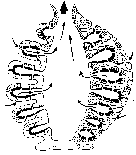 PORIFERA
(SPONGE): This soft, porous specimen represents a very primitive invertebrate.
Sponges that are used today for cleaning are synthetic. However, if you look
at a synthetic sponge, you notice that it looks like a real sponge. In the
early days, people used sponges for soaking up water.
PORIFERA
(SPONGE): This soft, porous specimen represents a very primitive invertebrate.
Sponges that are used today for cleaning are synthetic. However, if you look
at a synthetic sponge, you notice that it looks like a real sponge. In the
early days, people used sponges for soaking up water.
Water containing nutrients, enters pores
of sponges. Waste is released through larger openings called "oscula."
Look for the different size openings on the specimens.
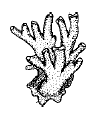 CNIDARIA (CORAL): Cnidaria are organisms with a central stomach
surrounded by stinging cells on the end of finger-like projections. This
phylum includes jellyfish, sea anemones, and corals. Coral heads are the
skeletal remains of living corals. They are rough in texture and come in a
variety of shapes, sizes, and colors. Corals are classified as soft and hard
corals. The coral samples you see have tiny holes which once contained a
single organism.
CNIDARIA (CORAL): Cnidaria are organisms with a central stomach
surrounded by stinging cells on the end of finger-like projections. This
phylum includes jellyfish, sea anemones, and corals. Coral heads are the
skeletal remains of living corals. They are rough in texture and come in a
variety of shapes, sizes, and colors. Corals are classified as soft and hard
corals. The coral samples you see have tiny holes which once contained a
single organism.
Examples from this phylum have holes,
rough textures, radiating walls or branches, and are mostly white when dead.
Coral may form large reefs, like the Great Barrier Reef in Australia, which
serve as homes and shelters for fish and other sealife.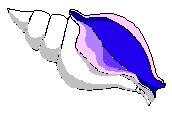
MOLLUSCA
(CLAM, MUSSEL, SCALLOP, SNAIL): Specimens from this group of invertebrates
have hard shells, curved or twisted bodies, one or two shell parts, and an
unsegmented body. Many animals from this phylum can be found at stores or
seafood restaurants as clam chowder, seafood platters, or escargot.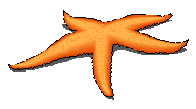
ECHINODERMATA (SEA
COOKIE, SEASTAR, SEA URCHIN): This phylum consists of animals that have a
5-arm pattern, sometimes brittle bodies, and circular holes that allow the
entrance and removal of food and waste. One example, the familiar seastar, can
grow back body parts that are cut off or lost.
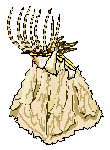 ARTHROPODA (BARNACLE): This phylum consists of segmented or jointed
invertebrates including insects, spiders, and crustacea. A barnacle is a
shrimp-like arthropod with a shell. Students will not be able to see the
arthropod itself, only the shell that houses the organism when it is alive.
ARTHROPODA (BARNACLE): This phylum consists of segmented or jointed
invertebrates including insects, spiders, and crustacea. A barnacle is a
shrimp-like arthropod with a shell. Students will not be able to see the
arthropod itself, only the shell that houses the organism when it is alive.
PROCEDURE:
- Students will examine specimens of
invertebrates in this lab activity. Invertebrates are animals that lack a
backbone and comprise 97% of the Animal Kingdom. Discuss techniques on
observing the specimens using the senses of touch, sound, and sight.
- Students should determine which
samples belong together by describing characteristics such as texture, shape,
growth patterns, hardness, and color. Each of the specimens is an individual
species. Emphasize with students that there are many other species within
these groups.